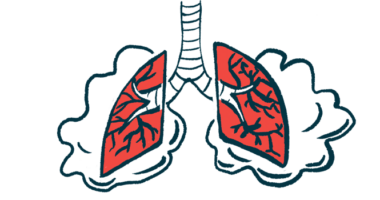Trikafta can treat CF in patients with N1303K mutation, study finds
Common but rare variant not among mutations approved for therapy

Treatment with Trikafta (elexacaftor/tezacaftor/ivacaftor) can improve lung function and nutritional status for people with cystic fibrosis (CF) caused by the N1303K mutation, a small real-world study reports.
The N1303K mutation is not among the 178 disease-causing mutations in the CFTR gene considered to be responsive to Trikafta and eligible for its use under a recent update to the U.S. Food and Drug Administration’s prescribing label.
“We report the clinical benefits of treatment with [Trikafta] seen in [people with] CF who carry the N1303K mutation,” the researchers wrote, adding that the improvements seen “are important factors that are associated with morbidity, mortality and quality of life of [in people with] CF.”
The study, “Clinical and functional efficacy of elexacaftor/tezacaftor/ivacaftor in people with cystic fibrosis carrying the N1303K mutation,” was published in the Journal of Cystic Fibrosis.
Study into real-world use of Trikafta by 8 patients with an N1303K mutation
CF is caused by mutations in the gene that provides instructions for making the CFTR protein. Trikafta contains a combination of three CFTR modulators, which can bind to certain mutated forms of this protein to help improve its functionality.
In the U.S., Trikafta is authorized to treat patients as young as 2 years old who carry at least one copy of F508del, which is the most common CF-causing mutation. Trikafta also is authorized for use in patients who have 177 other mutations known to respond to its combination of CFTR modulators based on laboratory data. Therapy approvals, however, were supported primarily by clinical trials that tested Trikafta in people with at least one copy of F508del.
Study researchers describe N1303K as the third most common CF-causing mutation, while other studies refer to N1303K as being “among the more common rare CF mutations.” Either way, its presence results in the production of a CFTR protein that’s unstable and cannot function correctly. Some laboratory studies in cellular models indicated that Trikafta can help to improve the protein’s functionality in cells carrying the N1303K mutation, but others showed conflicting results. Clinical data from patients have been scant.
Researchers reported on outcomes for eight CF patients treated off-label with Trikafta in Israel. All eight carried either two copies of the N1303K mutation, or one copy of N1303K alongside either a nonsense or frameshift mutation, which were not expected to respond to Trikafta.
Results showed that measures of lung function improved significantly after starting on Trikafta. The percent predicted forced expiratory volume in one second (FEV1) — a common measure based on how much air a person can exhale in a quick, forceful breath — increased from an average of 69.2% before treatment to 87.6% after starting Trikafta.
While these numbers reflect averages, all eight individuals experienced some improvement in FEV1. Another lung function measure called the lung clearance index, which assesses how long it takes for a tracer gas to be cleared from the lungs, also showed significant improvement for patients with available measurements.
One patient on long-term oxygen use and a lung transplant candidate was able to stop oxygen treatment and be taken off the transplant list following treatment with Trikafta, the researchers noted.
Gains in lung function, body mass index seen with therapy’s use
All eight patients also had pancreatic insufficiency, a common complication of cystic fibrosis that makes it harder for the body to digest certain foods, particularly fats. People with pancreatic insufficiency struggle to get sufficient nutrients from their food, and they tend to lose weight.
After starting on Trikafta, all the patients experienced an increase in body mass index (BMI, a ratio of weight to height), suggesting the therapy helped in them gaining weight.
The CFTR protein normally helps to control levels of chloride, a type of salt molecule. As a consequence, CF patients tend to have high levels of chloride in their sweat. After starting on Trikafta, sweat tests showed a decrease in chloride levels for six of the eight patients, with one individual showing no change and another an increase in sweat chloride levels.
Unlike changes with treatment in patients’ lung function and BMI, the average change in sweat chloride was not statistically significant.
Another indirect measure of CFTR protein function, called nasal potential difference, normalized in four of the seven patients tested, showing partial response. Based on the contrast between these data and the clear symptom improvements, the researchers suggested this may indicate that the activity of Trikafta is different in airway, gastrointestinal, and sweat gland cells, or that different CFTR mutations lead to variable protein processing depending on the specific tissue.
Cellular samples collected from some of the patients were used to generate laboratory models to test CFTR function, including intestinal organoids (3D “mini-organs”). Data from these laboratory tests indicated that Trikafta boosted the protein’s functionality, although its effect was “moderate” in the organoids carrying an N1303K mutation relative to those with two F508del mutations.
Still, “we show a significant increase in CFTR function in five intestinal organoids after treatment with [Trikafta], which is in agreement with the clinical response,” the scientists wrote.








